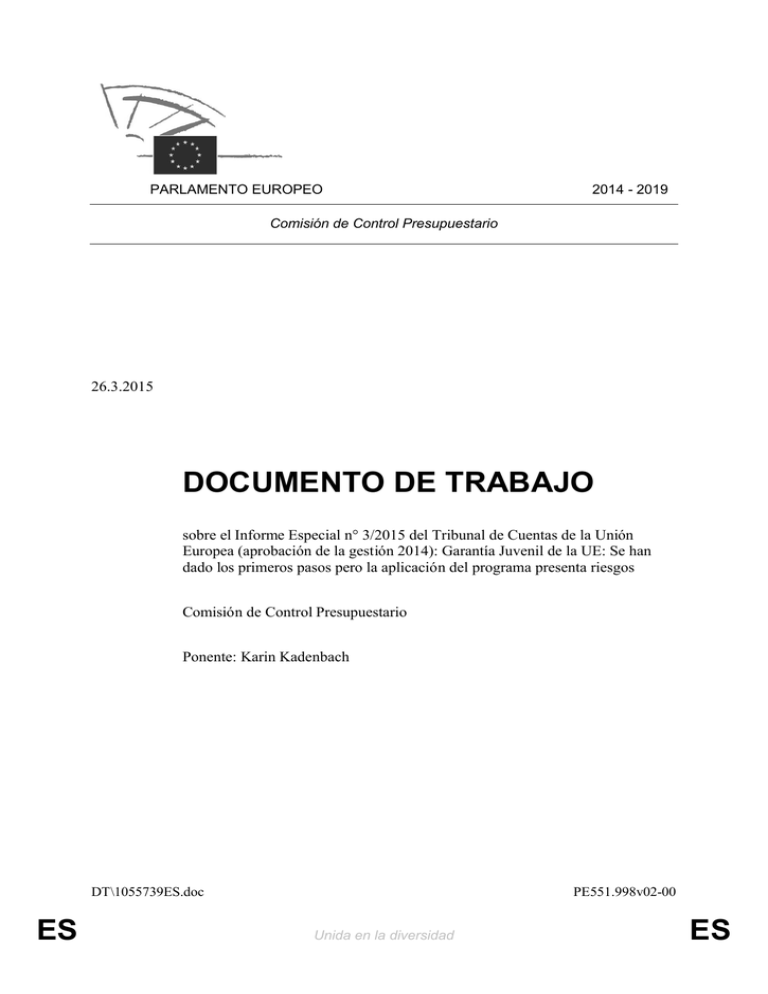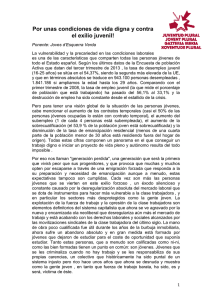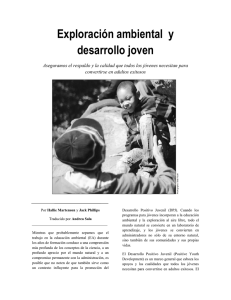es es documento de trabajo - European Parliament
Anuncio

PARLAMENTO EUROPEO 2014 - 2019 Comisión de Control Presupuestario 26.3.2015 DOCUMENTO DE TRABAJO sobre el Informe Especial n° 3/2015 del Tribunal de Cuentas de la Unión Europea (aprobación de la gestión 2014): Garantía Juvenil de la UE: Se han dado los primeros pasos pero la aplicación del programa presenta riesgos Comisión de Control Presupuestario Ponente: Karin Kadenbach DT\1055739ES.doc ES PE551.998v02-00 Unida en la diversidad ES Introduction Over the last decade, and in particular since the beginning of the economic and financial crisis, the number of unemployed people in the EU has increased considerably. The average unemployment rate for young people aged between 15 and 24 was of 22% in the EU in June 2014, and in some Member States the jobless rate is as high as half of all young people The gap between the countries with the highest and the lowest jobless rates for young people is extremely high. There is a gap of 44 percentage points between the Member State with the lowest rate of youth unemployment (Germany at 7.2% in December 2014) and the Member State with the highest rate, Spain (51.4% in December 2014). Spain is followed by Greece (50.6% in October 2014), Croatia (44.8% in the fourth quarter 2014) and Italy (42% in December 2014). The EU framework to combat youth unemployment was firstly launched in 2010 with the "Youth on the Move" Europe 2020 flagship initiative (COM(2010) 744 final of 15 September 2010). In December 2011, the Commission proposed a "Youth Opportunities Initiative" (COM(2011) 933 final of 20 December 2011) and in January 2012 it announced that it would work with the eight Member States most affected by youth unemployment by establishing "Youth Action Teams" with a view to making better use of the EU funding still available under the 2007-2013 programming period. The establishment of the "Youth Guarantee" was adopted by the EU's Council of Ministers in April 2013 (Council Recommendation of 22 April 2013) and further endorsed by the June 2013 European Council (European Council Conclusions, 27-28 June 2013). In 2014 youth unemployment was still at alarmingly high levels within the EU and needed to be urgently tackled. The Youth Guarantee was created to support young people in finding a job and to implement structural reform to improve school-to-work transitions. It promotes one of four alternative offers - job, apprenticeship, traineeship or continued education - to young people which are neither in employment nor in any education or training and should be delivered by the Member States in accordance with national, regional and local circumstances. The Youth Guarantee scheme is financed through the Youth Employment Initiative (YEI), the European Social Fund (ESF) and from national budgets. The ESF is the most important source of EU financing for it. The Commission latest estimations is that 3,2 billion euro from the ESF are required to match YEI funding. The ESF can finance measures specifically targeting individuals as well as those relating to structural reforms. To top up available EU financial support to the most affected regions, the Council and the European Parliament agreed to create a dedicated 6,4 billion euro Youth Employment Initiative. The YEI funding consists of 3,2 billion euro from a specific new EU budget line dedicated to youth employment which is to be matched by at least 3,2 billion euro from national allocations under the ESF. Unlike the ESF part, the specific allocations for the YEI is not subject to the national co-financing requirement and costs incurred by Member States since 1 September 2013 are eligible for reimbursement on a retrospective basis. The International Labour Organisation has estimated the cost of setting up Youth Guarantees in the Eurozone at €21 billion per year. However, the costs of NOT acting are far higher. The European Foundation for Living and Working Conditions (Eurofound) has estimated the PE551.998v02-00 ES 2/6 DT\1055739ES.doc economic loss in the EU of having millions of young people out of work, education or training at over €150 billion in 2011 (1.2% of EU GDP), in terms of benefits paid out and lost output. The YEI is part of the overall ESF programming and approved either in specific YEI Operational Programmes or as part of ESF Operational Programmes as a priority axis or even as part of a priority axis. It is concentrated on regions experiencing youth unemployment rates above 25% and on young people not in employment, education or training. Assessment Taking into account the above mentioned elements, the role of the Commission is to encourage Member States to make best use of the ESF and the YEI to support the set-up and implementation of Youth Guarantee schemes as policy instrument for combating and preventing youth unemployment and social exclusion. In addition the Commission is required to monitor the design, implementation and results of the YG schemes, analyse the impact of the policies in place and address, where appropriate, country-specific recommendations to Member States. On the other hand, the Member States commit to submit their Youth Guarantee Implementation Plans to the Commission for assessment. The Court assessed in this audit whether the Commission provided appropriate support to five Member States (Ireland, Italy, Lithuania and Portugal - which had Youth Action Teams - and France) in setting up the Youth Guarantee scheme and reviewed possible implementation risks. The audit period went from April 2013 to June 2014 and included information provided until February 2015. The Court observed that the Commission produced guidance on designing Youth Guarantee scheme and provided it to Member States within five months after the adoption of the Council Recommendation in April 2013. It produced a template with key elements for building a comprehensive implementation plan and published "Frequently Asked Questions" and organised thematic events. The Commission also carried out a comprehensive and timely assessment of the draft Youth Guarantee Implementation Plans (YGIPs) submitted by Member States and identified many shortcomings in those drafts. However, there are three elements which the Commission have not properly tackled. The ICT/digital skills which were identified as having great potential for the creation of sustainable jobs; the principle of mutual obligation which foresees on one side the existence of individual responsibility in finding a route into economic activity through one of the offers received and on the other the provision of unemployment or social assistance benefits until the person gets a reasonable offer; and the principle of mutual learning between all the parties involved at national regional or local levels in combating youth unemployment. The Court observed as well that not all Member States submitted a revised YGIP following the Commission's assessment identifying shortcomings. Moreover, the Court pointed out that the Commission assessment of YGIPs was not sufficiently co-ordinated with its assessment of the ex-ante conditionality for ESF/YEI operational programmes, which sets the strategic policy framework for promoting youth employment. DT\1055739ES.doc 3/6 PE551.998v02-00 ES When analysing the enforcement, the Court identified a number of risks to the effective implementation of the Youth Guarantee scheme. Firstly, the risk that the total funding may not be adequate as there are no real figures for the cost of implementing the Youth Guarantee in each Member State and no impact assessment carried out for those schemes. In addition, the Court did not find any robust estimation of costs for specific measures, like the sources of funding and its allocation to the different key reforms and measures in a financing plan, of the Youth Guarantee schemes. With the particular challenge of verifying the regularity of the YEI expenditure, that have been incurred since September 2013. Secondly the lack of definition of good-quality job offer may hamper the effectiveness of the Youth Guarantee. Thirdly, a comprehensive Youth Guarantee monitoring and reporting framework is still being developed. Currently the Commission monitors the implementation of YG through the multilateral surveillance of the Employment Committee1 within the framework of the European Semester. However, the results are not reported to the European Parliament and, even if some specific indicators were developed, as they are not mandatory, they result into varied input from the different Member States. Furthermore, the Country Specific Recommendations related to youth unemployment were not measurable and depend on political commitment at national level. In addition, as the reporting on the nationally funded part of the YG is not covered by the reporting obligations, there is the risk of having an uncompleted overview of how and to what extent the YG as a whole contributes to tackling youth unemployment. Finally, the Court has examined the relevance of the YEI result indicators as set out in the ESF Regulation and considered that some of them could be more detailed when approving future ESF/YEI Operational Programmes or amending the existing ones. European Court of Auditors (ECA) conclusions The Court concluded that the Commission provided adequate and timely support to the Member States in the process of setting up the Youth Guarantee, and carried out a comprehensive and timely assessment of the draft YGIPs submitted by the Member States, having also identified several shortcomings. Some aspects lacked proper assessment. The Court identified a number of risks relating to the adequacy of the total funding and the nature of a ”good-quality offer” , as well as monitoring and reporting arrangements for the Youth Guarantee scheme. ECA recommendations In light of its findings and in order to improve the effectiveness of the EU funding of the EU Youth Guarantee, the ECA recommends that: 1 An advisory committee for Employment and Social Affairs Ministers in the Employment and Social Affairs Council. PE551.998v02-00 ES 4/6 DT\1055739ES.doc 1. The Member States should provide a clear and complete overview of the cost of all planned measures to combat youth unemployment under the Youth Guarantee scheme in order that the Commission can assess the overall funding needs; 2. The Commission should promote a set of qualitative attributes that should be fulfilled for jobs, traineeships and apprenticeships to be supported from the EU budget. This could be based on the elements which define a good-quality offer in the Commission Guidance for evaluation of the YEI; 3. The Commission should put in place a comprehensive monitoring system for the Youth Guarantee scheme, covering both structural reforms and measures targeting individuals. The result of this monitoring should be reported to the European Parliament and the Council. Recomendaciones de la ponente para su posible inclusión en el informe de aprobación de la gestión de la Comisión para 2014 Acoge con satisfacción el Informe especial del Tribunal titulado «Garantía juvenil de la UE: Se han dado los primeros pasos pero la aplicación del programa presenta riesgos» y apoya las recomendaciones que contiene; Observa que el Tribunal está efectuando una evaluación intermedia de la iniciativa y celebra la ambición del Tribunal a la hora de empezar a valorar el uso de los fondos de la UE en una fase temprana; Subraya que la Garantía Juvenil es un elemento esencial para hacer frente al desempleo de los jóvenes; acoge con satisfacción que los jefes de Estado y de Gobierno de la UE hayan decidido destinar 6 400 millones de euros a través de fondos de la Unión (3 200 millones de euros del Fondo Social Europeo y 3 200 millones de euros procedentes de una nueva línea presupuestaria); señala que, si bien ello constituye un buen punto de partida, no resulta suficiente para que la Garantía Juvenil sea un éxito y pide por tanto a la Comisión que vele por que se encuentren más fondos para apoyar la Garantía Juvenil a lo largo del periodo de siete años; Considera que la financiación de la Garantía Juvenil es sumamente compleja al contar con varias opciones a través del Fondo Social Europeo (FSE) y la Iniciativa de Empleo Juvenil; pide a la Comisión que facilite orientación a las autoridades de los Estados miembros teniendo debidamente en cuenta que las autoridades locales, regionales y nacionales se enfrentan a retos diferentes a la hora de llevar esta iniciativa a la práctica y, por consiguiente, necesitan directrices específicas; Opina que la Comisión ha destinado importantes recursos para garantizar que esta medida sea eficaz para luchar contra el desempleo juvenil, pero lamenta que se haya puesto mucha menos energía a la hora de coordinar su aplicación por parte de los Estados miembros; DT\1055739ES.doc 5/6 PE551.998v02-00 ES Señala que no solo la disponibilidad de los fondos, sino también una utilización satisfactoria de los mismos son condiciones necesarias para la aplicación eficaz de la Garantía Juvenil; lamenta por tanto que, en varias regiones de Europa, el índice de utilización del FSE sea muy bajo; pide a los Estados miembros que garanticen las competencias administrativas y de recursos humanos necesarias para una utilización satisfactoria de los fondos asignados con miras a la aplicación de la Garantía Juvenil; Pide a la Comisión que elabore un sistema global de supervisión que abarque una serie de normas para evaluar la aplicación de las medidas de la Garantía Juvenil y su eficiencia en los Estados miembros; pide asimismo a la Comisión que examine la posibilidad de incluir objetivos obligatorios para la lucha contra el desempleo juvenil en el marco del Semestre europeo; Señala que la UE no dispone de competencias vinculantes en lo que respecta a las políticas activas del mercado laboral, pero destaca la necesidad de que la Comisión ofrezca a los Estados miembros ejemplos de buenas prácticas sobre la manera de aplicar la Garantía Juvenil; Pide a los Estados miembros que, con objeto de garantizar una aplicación satisfactoria y un impacto positivo a largo plazo, procedan a los cambios institucionales que resulten necesarios y cooperen con las entidades locales, las autoridades educativas, los servicios públicos de empleo, la industria y el comercio locales, los sindicatos y las asociaciones juveniles; Acoge con satisfacción la propuesta de la Comisión por la que se modifica el Reglamento nº 1304/2013 relativo al Fondo Social Europeo, a favor de un aumento del importe de la prefinanciación inicial abonada a los programas operativos apoyados por la Iniciativa de Empleo Juvenil, en la que se propone aumentar la prefinanciación inicial en 2015 de aproximadamente un 1 % a un 30 % para la asignación destinada a la Iniciativa de Empleo Juvenil; señala que, con objeto de permitir una rápida ejecución de los programas operativos apoyados por la Iniciativa de Empleo Juvenil, la Comisión debe comprometerse a abonar el importe de prefinanciación a los Estados miembros inmediatamente después de la entrada en vigor de dicho Reglamento; Considera que las políticas del mercado laboral en relación con la oferta deben considerarse conjuntamente con las políticas de educación, juventud y bienestar, así como en un contexto macroeconómico más amplio. PE551.998v02-00 ES 6/6 DT\1055739ES.doc





